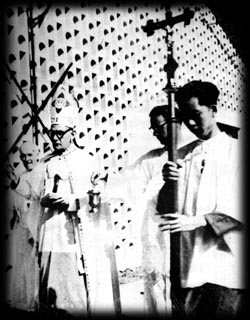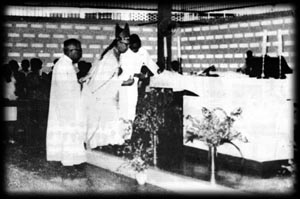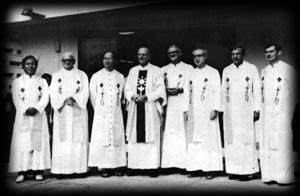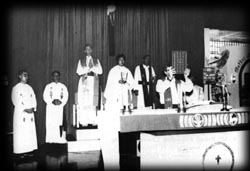History of the Parish in
Bandar Seri Begawan

The Early Beginnings Until 1940
The first missionaries called into Brunei in 1587. Two Spanish Franciscan priests, Francesco de Santa Maria and Miguel de Plasencia, on the way to Rome from Manila, stopped in Brunei. They were so well received by the Sultan. Some became apprehensive of their presence. One time after Fr. Francesca said Mass, he was speared and beheaded. When the Sultan heard of Fr. Francesca's death, he immediately sent messengers to present his regrets. The Sultan also ordered the return of Fr. Francesca's head so that it could be interred with the rest of his body.
Nearly three centuries later, in 1857, a mission was started on a site acquired at a place called Barambangan, about a mile from Brunei Town. Fr. Rive of the Milan Foreign Missionaries was put in charge of this mission.
Many were baptized. Soon, Fr. Rive was looking after a sizeable Christian community. He also made some contacts with the Muruts in the interior. In the course of his missionary work, he suffered a good deal from local harassment. His superiors feared that he might be killed, and eventually he was withdrawn from Brunei. Whatever became of the Christians after that, no one knows. However, the seeds of Christianity were sown by the first missionaries, and the Church in Brunei Darussalam owes a debt of gratitude to them.
The Early Beginnings Until 1940
Almost nothing is known about the history of the Church in Brunei from the
time the first missionaries left until the beginning of this century. However,
we do know that long before the first Catholic Priest regularly visited Brunei
in this century, a few Catholic families were already living here. Among the
very first Catholic families were the Newn family and the Liew family. The
heads of these families had become Catholics after they had been educated
in Catholic schools in Kuching.
The Mill Hill Missionaries arrived in Borneo in 1881 and by 1885, there was a resident priest in Labuan. Brunei was regarded as an outstation of Labuan. When babies were born to the few Catholic families in Brunei, they were all taken all the way to Labuan for baptism. The Baptismal Records indicate that the first Bruneians to be baptized in Labuan were Lucia Liew, baptized on 24th August, 1916, followed by Alice Liew, baptized on 26th November, 1917. Alice Liew, who was educated at the Convent in Labuan, became a Carmelite Nun, and was the first Bruneian to enter a religious order.
The first recorded baptism in Brunei was that of Francis Newn on 5th March 1919 by Fr. A. Williams, MHM, who came to visit Brunei from Labuan. Fr. Williams made regular visits to Brunei to minister the needs of the Catholic families. The Baptismal records show that he came regularly until 1930 when Fr. Stotter took over from him. By that time, there had been 18 baptisms in Brunei.

After Fr. Williams, several other Catholic priests from Labuan as well as other parts of Borneo continued to visit Brunei to minister. One of them was Monsignor A. Watcher, the Apostolic Prefect of North Borneo stationed in Penampang, who visited Brunei once a year. During these visits, Msgr. Watcher also used to call on His Majesty Sultan Ahmed Tajudin.
Not much was recorded about Brunei until 1927 when Brunei was included in the new Prefecture of North Borneo.
Because of the discovery of oil in Seria, the first resident priest for Brunei Fr. Crowther, MHM was appointed to Kuala Belait in 1936. Fr. Crowther also made regular visits to Brunei Town.
The following year, Fr. Piet de Wit was appointed resident priest in Brunei Town, as assistant to Fr. Crowther. Fr. Piet de Wit started the first Catholic school in a rented house owned by Mr. Kay in Jalan Padang, which also housed a chapel and the living quarters of the priest.

By 1941 a building to house the activities of the church had been constructed at Kumbang Pasang on the land donated by Mr. George Newn Ah Foott. The school building by this time included a small chapel and living quarters for the resident priest. The priest was also the principal of the school.
During the Japanese Occupation of 1942-1945, Fr. Piet de Wit together with the other priests were interned by the Japanese and sent to Batu Lintang, Kuching. As the Japanese used their church during those times, the Anglicans also used the school building for their services.

After the war, a few visiting army chaplains came to visit Brunei to look after the Catholic Community. The school was re-established and managed by Mr. George Newn Ah Foott, with his daughters as the teachers. The Mill Hill Missionary priests continued to come to Brunei from Labuan. Among then were Fr. McCarthy, Fr. Ben Walsh and Fr. William Smit. It was Fr. Smit who gave the school the name St. George's School, after its founder and benefactor.
In 1952, the Church in Brunei was included in the newly created Vicariate of Kuching. Bishop John de Vos was the first Apostolic Vicar of Kuching. After a long period without a resident priest in Brunei Town, Fr. Delaney was appointed the resident priest in 1953, with Fr. Jackson helping out on occasion. Fr. Delaney was instrumental in getting a new church constructed.

Fr. Delaney successfully completed a new building for the church. The new building, named St. George's Church, was opened by Bishop John de Vos on Easter Sunday in 1957. The building later became the present Parish Hall. The altar of this church was consecrated by Bishop de Vos on 9th October, 1959.
On 19 December 1959, the Vicariate of Miri-Brunei was erected. By 5th April 1960, Bishop Galvin was appointed Apostolic Vicar.

Fr. Delaney built in 1962 the present Parish House. In 1963, the school building was rebuilt to its present structure.
Fr. Conway was appointed to St. George's School from July, 1964 to June, 1965. He was followed by Fr. Wolbers. In September, 1966, Fr. M. Reynolds was assigned to Brunei Town after Fr. Delaney left. In that same year, Fr. Wolbers was made the Acting Rector and school principal.
Fr. Wolbers pressed for the construction of a new church. By 1968, the construction of the new church started.
In January 1969, when Fr. Wolbers left, Fr. Jan Dekker was sent as a temporary replacement. During this period, Bishop Galvin appointed a layman, Mr. Guy Alwines, as Principal of St. George's School.

In August 1969, Fr. Paul Tong was appointed Rector. It was at this time that the present Church building was completed, and the dedication of the new Church took place in 1969 on the Feast of the Assumption.
Fr. Tong was followed by Fr. Francis de Vries in 1970 and by Fr. Thomas Keogan in 1974.
Fr. Heuschen managed the school from 1972 and took over from Fr. Keogan who left in 1978. When Fr. Heuschen left in October, 1984, after working here for 13 years, Fr. Dunne took over for a short while before Fr. Peter Chiang was transferred here from the Seria Parish.
In 1989, Fr. Cornelius Sim, a native of Brunei, was ordained by Bishop Anthony Lee in Kuala Belait. Shortly after that, in 1991, both Fathers Chiang and McClorey had to leave the country.
The departure of the last two foreign priests was a time of great trial for the Catholic Church in Brunei,

with the burden of responsibility for the care of all the three parishes falling on the shoulders of the single parish priest, Fr. Cornelius Sim. Those were also times when the Catholics of Brunei rose to the occasion and courageously assisted Fr. Sim as he endlessly shuttled among the three parishes ministering to their needs.

In December, 1992, less than two years after Fathers Chiang and McClorey left Brunei, the Church in Brunei was blessed with the services of another local priest, Fr. Ivan Fang, MHM, who was appointed Parish Priest for the Church of Our Lady of the Assumption. Previously, Fr. Ivan served as a missionary in Pakistan for seven years since his ordination in St. Joseph's College, Mill Hill London.
One of the urgent needs that Fr. Ivan discerned was for the greater involvement of the laity of the Parish. In August 1993, the Pastoral Council was formed, thereby, providing opportunities for more and more parishioners to take an active role in the Parish. The Pastoral Council has also been able to bring about greater unity among the various organisations serving the community.